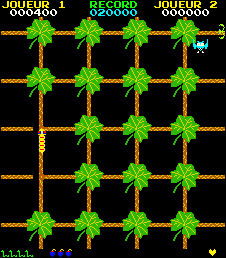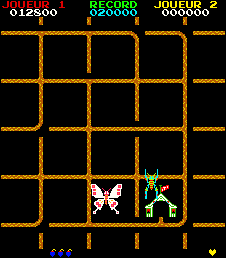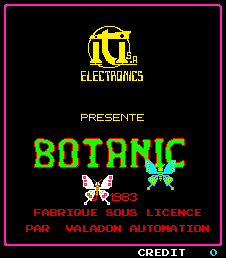 The Game: Players control a caterpillar, hungrily navigating a twisty maze of twigs and branches to eat leaves. Sometimes the player’s caterpillar will have reached a dead end, but this is not revealed until the leaf covering that dead end is consumed. Other insects swarm around the caterpillar, trying to catch and eat it for themselves. At the beginning of each “life” the player can press a button, giving the caterpillar a brief bug-zerker rage, allowing it to eat its enemies for a change, but this change is short-lived; special flowers must be consumed to regain the ability. Once all of the leaves have been eaten in an entire maze (which takes up more than a single interlinked screen), a “home” appears, into which the caterpillar must be successfully guided for transformation into a butterfly. Then the player is given a new caterpillar to guide and a new maze to navigate. (Valadon Automation [under license to Iti S.A.], 1983)
The Game: Players control a caterpillar, hungrily navigating a twisty maze of twigs and branches to eat leaves. Sometimes the player’s caterpillar will have reached a dead end, but this is not revealed until the leaf covering that dead end is consumed. Other insects swarm around the caterpillar, trying to catch and eat it for themselves. At the beginning of each “life” the player can press a button, giving the caterpillar a brief bug-zerker rage, allowing it to eat its enemies for a change, but this change is short-lived; special flowers must be consumed to regain the ability. Once all of the leaves have been eaten in an entire maze (which takes up more than a single interlinked screen), a “home” appears, into which the caterpillar must be successfully guided for transformation into a butterfly. Then the player is given a new caterpillar to guide and a new maze to navigate. (Valadon Automation [under license to Iti S.A.], 1983)
Memories: If you remember playing Botanic in your local arcade, your local arcade must have been in France or Spain, since Botanic did not receive worldwide distribution. Valadon Automation, the originators of Bagman (a game which did receive worldwide distribution), licensed Botanic from Palamos, Spain-based game maker Iti S.A.
 Botanic bears some thematic similarities with Orca‘s equally obscure coin-op Changes (1982), which also turned a caterpillar’s quest for survival and metamorphosis into a Pac-inspired maze game, but the two games are significantly different (and the theme is still a good idea for a game in either flavor). Botanic‘s fiendish dead-ends and hidden maze junctions deal the player quite a few sudden crises to solve, elevating it above a lot of “Pac-alikes” that stuck rather more slavishly to the mechanics of Pac-Man. While the dead-ends are likely to put the player’s crawler in deep trouble early on, the fields is leveled somewhat by the ability to trigger a very short-lived “power pellet” mode without having to eat anything.
Botanic bears some thematic similarities with Orca‘s equally obscure coin-op Changes (1982), which also turned a caterpillar’s quest for survival and metamorphosis into a Pac-inspired maze game, but the two games are significantly different (and the theme is still a good idea for a game in either flavor). Botanic‘s fiendish dead-ends and hidden maze junctions deal the player quite a few sudden crises to solve, elevating it above a lot of “Pac-alikes” that stuck rather more slavishly to the mechanics of Pac-Man. While the dead-ends are likely to put the player’s crawler in deep trouble early on, the fields is leveled somewhat by the ability to trigger a very short-lived “power pellet” mode without having to eat anything.
 Botanic is proof that there were good game ideas aplenty, even beyond Silicon Valley, Chicago, and Japan.
Botanic is proof that there were good game ideas aplenty, even beyond Silicon Valley, Chicago, and Japan.
Would Botanic have made a splash in the American  market? It’s difficult to say: there were already an awful lot of eat-stuff-in-a-maze games out there. Perhaps it was wise for Valadon and Iti to keep the game sequestered away to their part of the world as a local treasure.
market? It’s difficult to say: there were already an awful lot of eat-stuff-in-a-maze games out there. Perhaps it was wise for Valadon and Iti to keep the game sequestered away to their part of the world as a local treasure.